FIAT LINEA 2007 1.G Owners Manual
Manufacturer: FIAT, Model Year: 2007, Model line: LINEA, Model: FIAT LINEA 2007 1.GPages: 230, PDF Size: 3.31 MB
Page 151 of 230
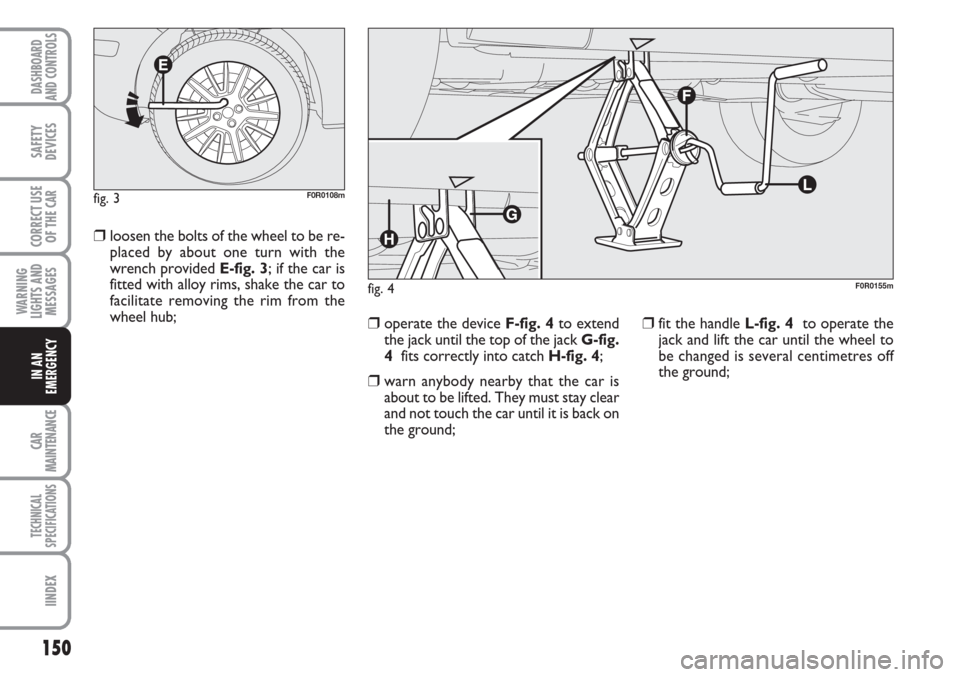
150
WARNING
LIGHTS AND
MESSAGES
CAR
MAINTENANCE
TECHNICAL
SPECIFICATIONS
IINDEX
DASHBOARD
AND CONTROLS
SAFETY
DEVICES
CORRECT USE
OF THE
CAR
IN AN
EMERGENCY
âť’loosen the bolts of the wheel to be re-
placed by about one turn with the
wrench provided E-fig. 3; if the car is
fitted with alloy rims, shake the car to
facilitate removing the rim from the
wheel hub;
âť’operate the device F-fig. 4to extend
the jack until the top of the jack G-fig.
4fits correctly into catch H-fig. 4;
âť’warn anybody nearby that the car is
about to be lifted. They must stay clear
and not touch the car until it is back on
the ground;
âť’fit the handle L-fig. 4to operate the
jack and lift the car until the wheel to
be changed is several centimetres off
the ground;
fig. 3F0R0108m
fig. 4F0R0155m
Page 152 of 230
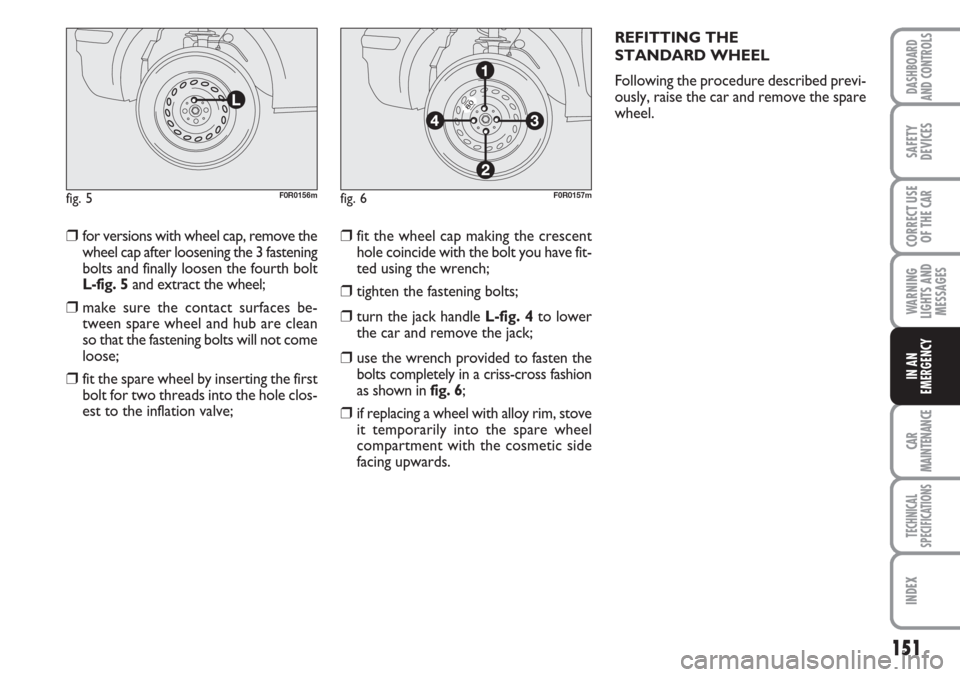
151
WARNING
LIGHTS AND
MESSAGES
CAR
MAINTENANCE
TECHNICAL
SPECIFICATIONS
INDEX
DASHBOARD
AND CONTROLS
SAFETY
DEVICES
CORRECT USE
OF THE
CAR
IN AN
EMERGENCY
âť’for versions with wheel cap, remove the
wheel cap after loosening the 3 fastening
bolts and finally loosen the fourth bolt
L-fig. 5and extract the wheel;
âť’make sure the contact surfaces be-
tween spare wheel and hub are clean
so that the fastening bolts will not come
loose;
âť’fit the spare wheel by inserting the first
bolt for two threads into the hole clos-
est to the inflation valve;
âť’fit the wheel cap making the crescent
hole coincide with the bolt you have fit-
ted using the wrench;
âť’tighten the fastening bolts;
âť’turn the jack handle L-fig. 4to lower
the car and remove the jack;
âť’use the wrench provided to fasten the
bolts completely in a criss-cross fashion
as shown in fig. 6;
âť’if replacing a wheel with alloy rim, stove
it temporarily into the spare wheel
compartment with the cosmetic side
facing upwards.REFITTING THE
STANDARD WHEEL
Following the procedure described previ-
ously, raise the car and remove the spare
wheel.
fig. 5F0R0156mfig. 6F0R0157m
Page 153 of 230
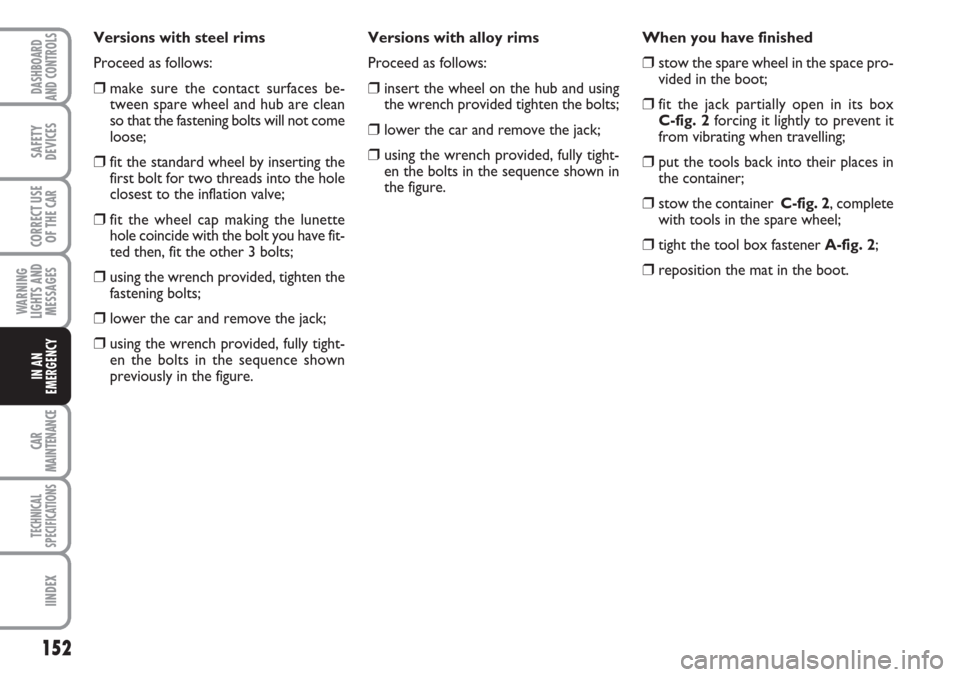
152
WARNING
LIGHTS AND
MESSAGES
CAR
MAINTENANCE
TECHNICAL
SPECIFICATIONS
IINDEX
DASHBOARD
AND CONTROLS
SAFETY
DEVICES
CORRECT USE
OF THE
CAR
IN AN
EMERGENCY
Versions with steel rims
Proceed as follows:
âť’make sure the contact surfaces be-
tween spare wheel and hub are clean
so that the fastening bolts will not come
loose;
âť’fit the standard wheel by inserting the
first bolt for two threads into the hole
closest to the inflation valve;
âť’fit the wheel cap making the lunette
hole coincide with the bolt you have fit-
ted then, fit the other 3 bolts;
âť’using the wrench provided, tighten the
fastening bolts;
âť’lower the car and remove the jack;
âť’using the wrench provided, fully tight-
en the bolts in the sequence shown
previously in the figure.Versions with alloy rims
Proceed as follows:
âť’insert the wheel on the hub and using
the wrench provided tighten the bolts;
âť’lower the car and remove the jack;
âť’using the wrench provided, fully tight-
en the bolts in the sequence shown in
the figure.When you have finished
âť’stow the spare wheel in the space pro-
vided in the boot;
âť’fit the jack partially open in its box
C-fig. 2forcing it lightly to prevent it
from vibrating when travelling;
âť’put the tools back into their places in
the container;
âť’stow the container C-fig. 2, complete
with tools in the spare wheel;
âť’tight the tool box fastener A-fig. 2;
âť’reposition the mat in the boot.
Page 154 of 230
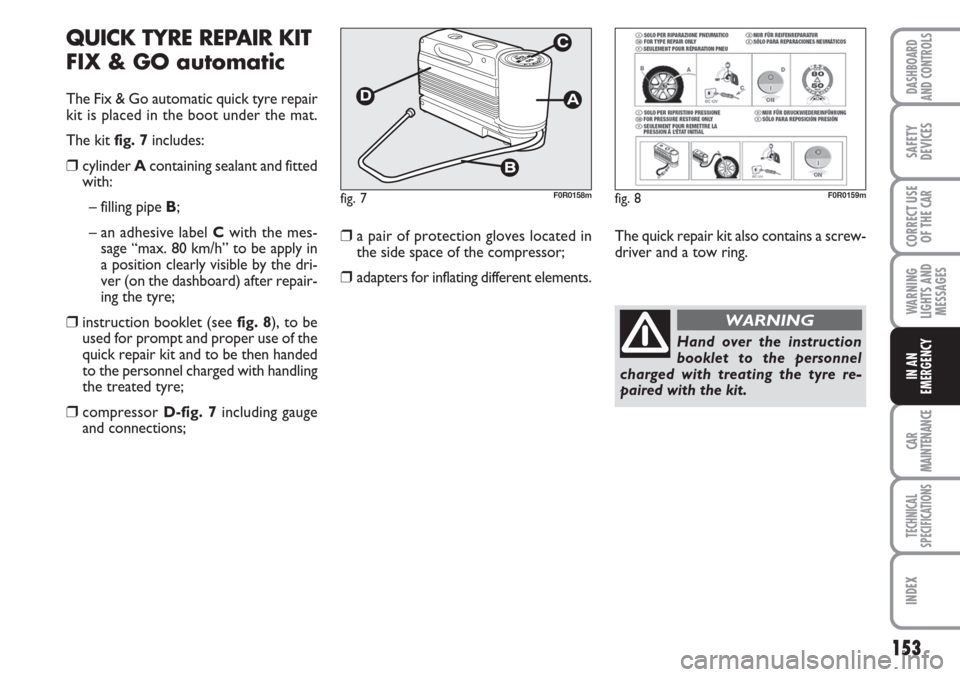
153
WARNING
LIGHTS AND
MESSAGES
CAR
MAINTENANCE
TECHNICAL
SPECIFICATIONS
INDEX
DASHBOARD
AND CONTROLS
SAFETY
DEVICES
CORRECT USE
OF THE
CAR
IN AN
EMERGENCY
QUICK TYRE REPAIR KIT
FIX & GO automatic
The Fix & Go automatic quick tyre repair
kit is placed in the boot under the mat.
The kit fig. 7includes:
âť’cylinder A containing sealant and fitted
with:
– filling pipe B;
– an adhesive label Cwith the mes-
sage “max. 80 km/h” to be apply in
a position clearly visible by the dri-
ver (on the dashboard) after repair-
ing the tyre;
âť’instruction booklet (see fig. 8), to be
used for prompt and proper use of the
quick repair kit and to be then handed
to the personnel charged with handling
the treated tyre;
âť’compressor D-fig. 7including gauge
and connections;
âť’a pair of protection gloves located in
the side space of the compressor;
âť’adapters for inflating different elements.
fig. 7F0R0158m
The quick repair kit also contains a screw-
driver and a tow ring.
fig. 8F0R0159m
Hand over the instruction
booklet to the personnel
charged with treating the tyre re-
paired with the kit.
WARNING
Page 155 of 230
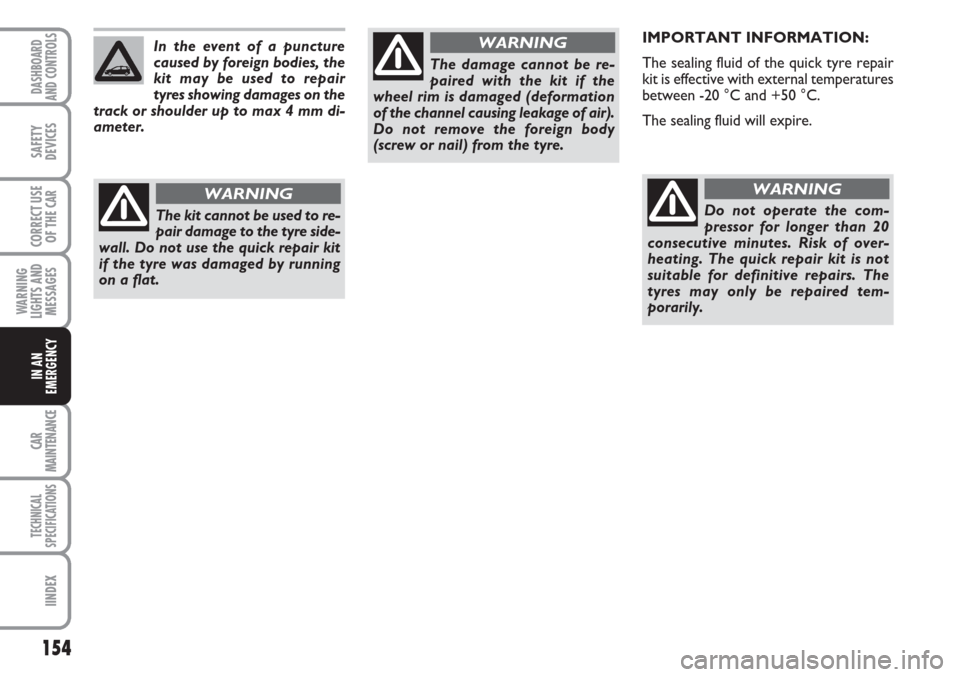
154
WARNING
LIGHTS AND
MESSAGES
CAR
MAINTENANCE
TECHNICAL
SPECIFICATIONS
IINDEX
DASHBOARD
AND CONTROLS
SAFETY
DEVICES
CORRECT USE
OF THE
CAR
IN AN
EMERGENCY
IMPORTANT INFORMATION:
The sealing fluid of the quick tyre repair
kit is effective with external temperatures
between -20 °C and +50 °C.
The sealing fluid will expire.
Do not operate the com-
pressor for longer than 20
consecutive minutes. Risk of over-
heating. The quick repair kit is not
suitable for definitive repairs. The
tyres may only be repaired tem-
porarily.
WARNING
In the event of a puncture
caused by foreign bodies, the
kit may be used to repair
tyres showing damages on the
track or shoulder up to max 4 mm di-
ameter.
The kit cannot be used to re-
pair damage to the tyre side-
wall. Do not use the quick repair kit
if the tyre was damaged by running
on a flat.
WARNING
The damage cannot be re-
paired with the kit if the
wheel rim is damaged (deformation
of the channel causing leakage of air).
Do not remove the foreign body
(screw or nail) from the tyre.
WARNING
Page 156 of 230
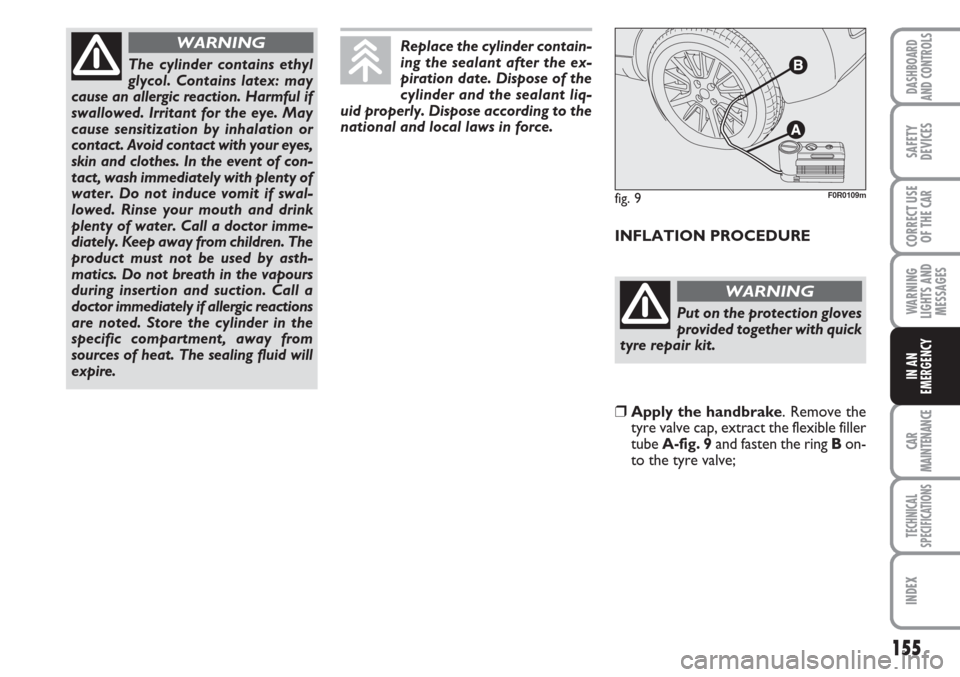
155
WARNING
LIGHTS AND
MESSAGES
CAR
MAINTENANCE
TECHNICAL
SPECIFICATIONS
INDEX
DASHBOARD
AND CONTROLS
SAFETY
DEVICES
CORRECT USE
OF THE
CAR
IN AN
EMERGENCY
INFLATION PROCEDURE
The cylinder contains ethyl
glycol. Contains latex: may
cause an allergic reaction. Harmful if
swallowed. Irritant for the eye. May
cause sensitization by inhalation or
contact. Avoid contact with your eyes,
skin and clothes. In the event of con-
tact, wash immediately with plenty of
water. Do not induce vomit if swal-
lowed. Rinse your mouth and drink
plenty of water. Call a doctor imme-
diately. Keep away from children. The
product must not be used by asth-
matics. Do not breath in the vapours
during insertion and suction. Call a
doctor immediately if allergic reactions
are noted. Store the cylinder in the
specific compartment, away from
sources of heat. The sealing fluid will
expire.
WARNINGReplace the cylinder contain-
ing the sealant after the ex-
piration date. Dispose of the
cylinder and the sealant liq-
uid properly. Dispose according to the
national and local laws in force.
Put on the protection gloves
provided together with quick
tyre repair kit.
WARNING
âť’Apply the handbrake. Remove the
tyre valve cap, extract the flexible filler
tube A-fig. 9and fasten the ring Bon-
to the tyre valve;
fig. 9F0R0109m
Page 157 of 230
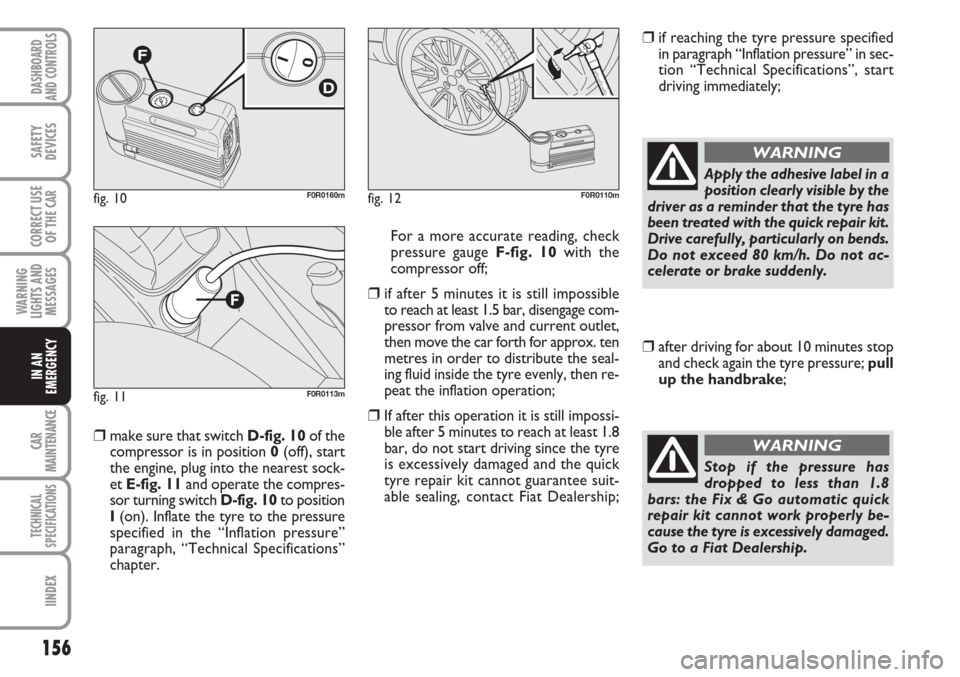
156
WARNING
LIGHTS AND
MESSAGES
CAR
MAINTENANCE
TECHNICAL
SPECIFICATIONS
IINDEX
DASHBOARD
AND CONTROLS
SAFETY
DEVICES
CORRECT USE
OF THE
CAR
IN AN
EMERGENCY
âť’make sure that switch D-fig. 10of the
compressor is in position 0(off), start
the engine, plug into the nearest sock-
et E-fig. 11and operate the compres-
sor turning switch D-fig. 10to position
I(on). Inflate the tyre to the pressure
specified in the “Inflation pressure”
paragraph, “Technical Specifications”
chapter. For a more accurate reading, check
pressure gauge F-fig. 10with the
compressor off;
âť’if after 5 minutes it is still impossible
to reach at least 1.5 bar, disengage com-
pressor from valve and current outlet,
then move the car forth for approx. ten
metres in order to distribute the seal-
ing fluid inside the tyre evenly, then re-
peat the inflation operation;
âť’If after this operation it is still impossi-
ble after 5 minutes to reach at least 1.8
bar, do not start driving since the tyre
is excessively damaged and the quick
tyre repair kit cannot guarantee suit-
able sealing, contact Fiat Dealership;
âť’if reaching the tyre pressure specified
in paragraph “Inflation pressure” in sec-
tion “Technical Specifications”, start
driving immediately;
fig. 10F0R0160m
fig. 11F0R0113m
fig. 12F0R0110m
Apply the adhesive label in a
position clearly visible by the
driver as a reminder that the tyre has
been treated with the quick repair kit.
Drive carefully, particularly on bends.
Do not exceed 80 km/h. Do not ac-
celerate or brake suddenly.
WARNING
âť’after driving for about 10 minutes stop
and check again the tyre pressure; pull
up the handbrake;
Stop if the pressure has
dropped to less than 1.8
bars: the Fix & Go automatic quick
repair kit cannot work properly be-
cause the tyre is excessively damaged.
Go to a Fiat Dealership.
WARNING
Page 158 of 230
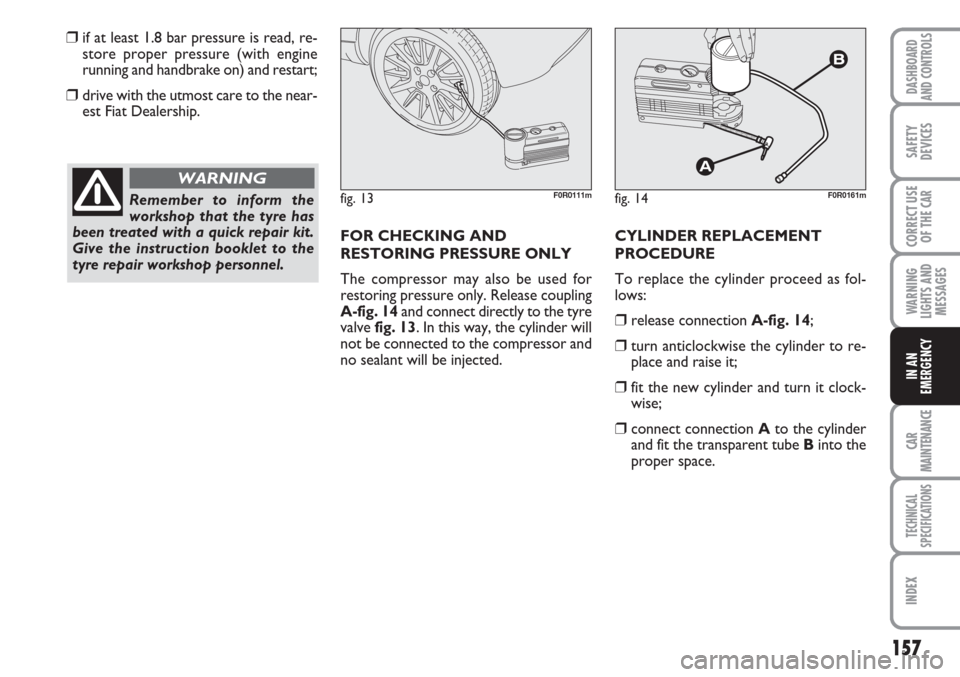
157
WARNING
LIGHTS AND
MESSAGES
CAR
MAINTENANCE
TECHNICAL
SPECIFICATIONS
INDEX
DASHBOARD
AND CONTROLS
SAFETY
DEVICES
CORRECT USE
OF THE
CAR
IN AN
EMERGENCY
âť’if at least 1.8 bar pressure is read, re-
store proper pressure (with engine
running and handbrake on) and restart;
âť’drive with the utmost care to the near-
est Fiat Dealership.
FOR CHECKING AND
RESTORING PRESSURE ONLY
The compressor may also be used for
restoring pressure only. Release coupling
A-fig. 14and connect directly to the tyre
valve fig. 13. In this way, the cylinder will
not be connected to the compressor and
no sealant will be injected. CYLINDER REPLACEMENT
PROCEDURE
To replace the cylinder proceed as fol-
lows:
âť’release connection A-fig. 14;
âť’turn anticlockwise the cylinder to re-
place and raise it;
âť’fit the new cylinder and turn it clock-
wise;
âť’connect connection Ato the cylinder
and fit the transparent tube Binto the
proper space.
Remember to inform the
workshop that the tyre has
been treated with a quick repair kit.
Give the instruction booklet to the
tyre repair workshop personnel.
WARNING
fig. 13F0R0111mfig. 14F0R0161m
Page 159 of 230
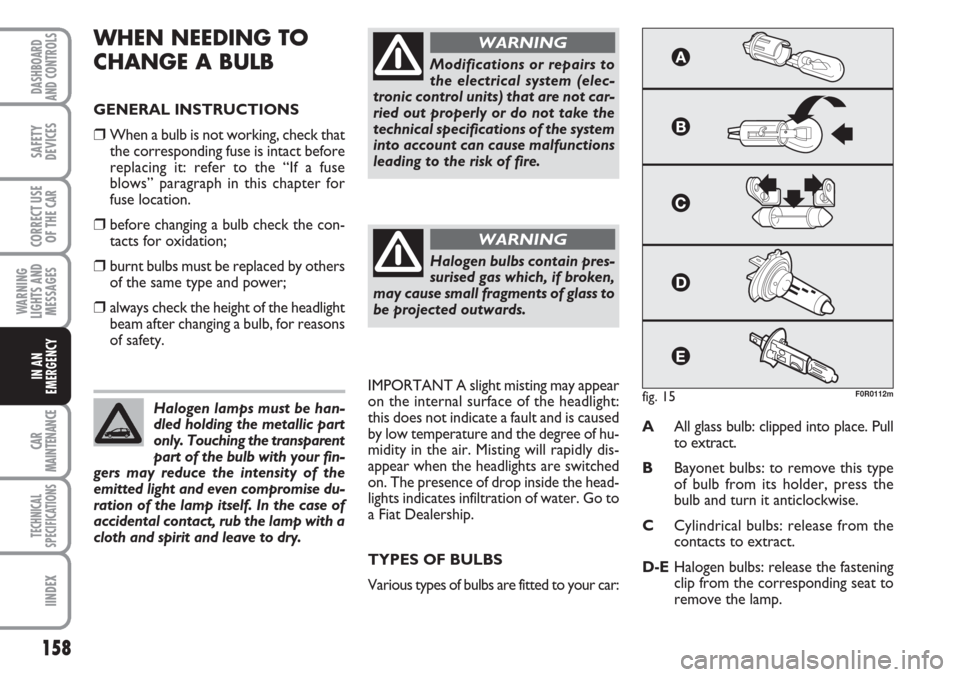
158
WARNING
LIGHTS AND
MESSAGES
CAR
MAINTENANCE
TECHNICAL
SPECIFICATIONS
IINDEX
DASHBOARD
AND CONTROLS
SAFETY
DEVICES
CORRECT USE
OF THE
CAR
IN AN
EMERGENCY
WHEN NEEDING TO
CHANGE A BULB
GENERAL INSTRUCTIONS
âť’When a bulb is not working, check that
the corresponding fuse is intact before
replacing it: refer to the “If a fuse
blows” paragraph in this chapter for
fuse location.
âť’before changing a bulb check the con-
tacts for oxidation;
âť’burnt bulbs must be replaced by others
of the same type and power;
âť’always check the height of the headlight
beam after changing a bulb, for reasons
of safety.
IMPORTANT A slight misting may appear
on the internal surface of the headlight:
this does not indicate a fault and is caused
by low temperature and the degree of hu-
midity in the air. Misting will rapidly dis-
appear when the headlights are switched
on. The presence of drop inside the head-
lights indicates infiltration of water. Go to
a Fiat Dealership.
TYPES OF BULBS
Various types of bulbs are fitted to your car:AAll glass bulb: clipped into place. Pull
to extract.
BBayonet bulbs: to remove this type
of bulb from its holder, press the
bulb and turn it anticlockwise.
CCylindrical bulbs: release from the
contacts to extract.
D-EHalogen bulbs: release the fastening
clip from the corresponding seat to
remove the lamp. Halogen lamps must be han-
dled holding the metallic part
only. Touching the transparent
part of the bulb with your fin-
gers may reduce the intensity of the
emitted light and even compromise du-
ration of the lamp itself. In the case of
accidental contact, rub the lamp with a
cloth and spirit and leave to dry.
Modifications or repairs to
the electrical system (elec-
tronic control units) that are not car-
ried out properly or do not take the
technical specifications of the system
into account can cause malfunctions
leading to the risk of fire.
WARNING
Halogen bulbs contain pres-
surised gas which, if broken,
may cause small fragments of glass to
be projected outwards.
WARNING
fig. 15F0R0112m
Page 160 of 230
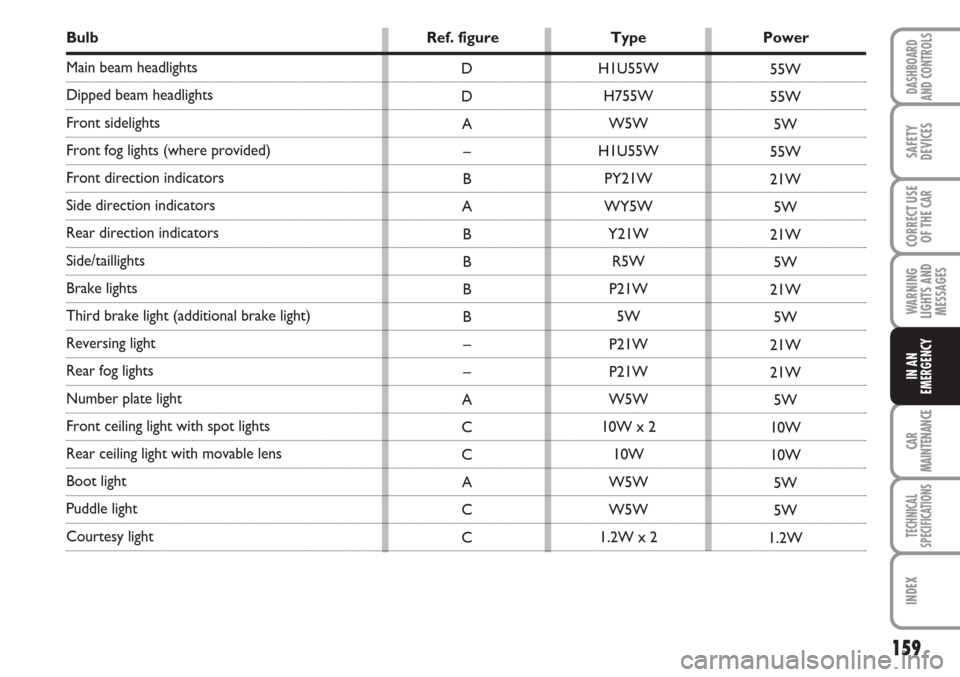
159
WARNING
LIGHTS AND
MESSAGES
CAR
MAINTENANCE
TECHNICAL
SPECIFICATIONS
INDEX
DASHBOARD
AND CONTROLS
SAFETY
DEVICES
CORRECT USE
OF THE
CAR
IN AN
EMERGENCY
Bulb Ref. figure Type Power
Main beam headlights
Dipped beam headlights
Front sidelights
Front fog lights (where provided)
Front direction indicators
Side direction indicators
Rear direction indicators
Side/taillights
Brake lights
Third brake light (additional brake light)
Reversing light
Rear fog lights
Number plate light
Front ceiling light with spot lights
Rear ceiling light with movable lens
Boot light
Puddle light
Courtesy light H1U55W
H755W
W5W
H1U55W
PY21W
WY5W
Y21W
R5W
P21W
5W
P21W
P21W
W5W
10W x 2
10W
W5W
W5W
1.2W x 2 D
D
A
–
B
A
B
B
B
B
–
–
A
C
C
A
C
C55W
55W
5W
55W
21W
5W
21W
5W
21W
5W
21W
21W
5W
10W
10W
5W
5W
1.2W